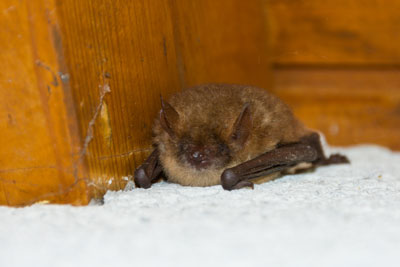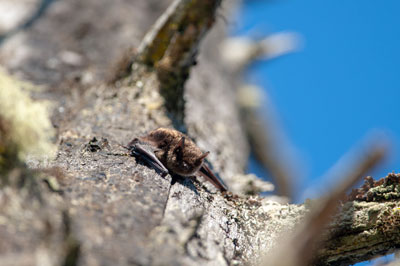




Bats flying in your backyard should be a welcome sight and not cause for alarm. Bats don't deserve the bad reputation they've inherited from scary movies and myths. Bats are passive, shy mammals and prefer to avoid contact with humans. They are extremely valuable in controlling insect pests. A single little brown bat can consume 1,200 mosquitoes in one hour. Bats save us billions of dollars annually by consuming agricultural insect pests such as moths, cucumber beetles, corn earworms, and grasshoppers. Montana has 15 species of bats. Some bats live in groups and others are solitary. Some might roost in a house if access is available and others would never enter a house. Several species have declined in numbers over the past few decades. Because of their beneficial contribution to reducing insect populations bats should be encouraged. Should a problem arise, home owners can exclude bats using humane, non-lethal methods.
Bats and humans can live near each other in harmony. Installing a bat house is one way to attract bats or provide an alternative roost for evicted bats. Bat houses may be purchased or you can build one. The Bat Conservation International, Inc. (BCI) is an excellent resource for information about bats. They provide The Bat House Builders Handbook if you need plans to build a bat house.
If you purchase a bat house, make sure is has the BCI Bat Approved certification and learn how to install it properly. Many bat houses fail because of poor design, or its location does not meet the needs of the bats. Bats like their houses hot. In Montana, bat houses need to be painted black or a very dark color, and hung on a building or pole where they receive at least eight hours of direct sunlight a day. Southeast facing exposures are best, to warm the house quickly after a cold night.
Enjoy Montana's bats; they are some of our more beneficial and fascinating wildlife residents.
Bats roosting in a building often go unnoticed for years. If they are not causing damage to the building then no action need be taken. You may hear sounds from bats vocalizing or crawling around. Bats make the most noise on hot days and when leaving the roost at dusk or returning at dawn. Bat droppings, called guano, may be found on the attic floor or can stain the ceiling or siding.
Bats can squeeze through cracks as small as 1-inch wide. They may enter through openings found around a chimney, attic, vent, or siding. To locate exit/entry points, watch from the corner of the building and look for bats flying in and out. Begin the watch 30 minutes before dusk and observe for 1 hour.
Its best to evict bats by allowing them to leave on their own and then denying entry. Seal all but the largest or most used entrance with building material (hardware cloth, netting or sheet metal).
The last entrance should be covered with garden netting. Hang it over the entry point so it extends 2 feet below and to each side of the opening. Only the bottom edge should hang loosely. This allows bats leaving the building to crawl under and out, but returning bats cannot find their way back in. Secure the net in place so that it hangs free an inch or so away from the building. It will act as a one-way valve, permitting exit but closing when bats land on it to return. Leave the netting up for several days before sealing the opening, as some bats will not leave to feed at night. Inspect the attic to see that bats have left or watch the outside of the house at dusk.
Never attempt to exclude bats between the months of May and August since there may be young present. A mother bat will be unrelenting when seeking a way back to her baby. And young bats may find their way into living spaces looking for their mother and will create an odor after they die. By September, young bats are flying and able to live on their own, so fall is the best time to evict bats.
There are methods you can use to make the roosting area undesirable:
Bats can live to be 30 years old, and the colony will attempt to return to their traditional roost. Installing a bat house will increase your success rates in keeping bats out of your house and reduce the local mosquito population.
Trapping is not recommended since excluding bats is less complicated to carry out, less time consuming, more effective, and requires no handling of bats.
Never attempt to poison bats! Poison is not effective because many of our bats are insectivorous, and bats often roost deep in cracks where the poison won't reach. Poisoned bats will leave the house sick, and are then more likely to bite pets or people.
Bats found in the living space of structures (bedrooms, kitchens, basements, etc.) should only be released when occupants are certain that no persons or pets have had direct contact with bats. Always capture bats found in rooms with individuals who were sleeping, with diminished mental capacity or young children as they may have had contact with a bat without their knowledge. Do not assume that victims or associates would be able to see bite marks. Bats have needle-like teeth that leave marks difficult to see even when you know where the individual was bitten. For questions about exposures to bats within the home and how to submit bats for testing, contact your local health department. Local health department contact numbers and other information can be found on the DPHHS Rabies webpage.
A bat that has not been in direct contact with humans as described above and does not need to be tested for rabies can be easily removed from your home. Confine it to one room, open a window or door leading outside, turn off the lights, and leave for 30 minutes to 1 hour. You can also wait until the bat stops flying, cover it with a coffee can or jar, and slide a piece of cardboard underneath the jar. Take the captive bat outside and release it after dark. Always wear leather work gloves when handling a bat. In some communities, your local Humane Society, animal shelter, or animal control officer can assist you with removal of single bats from your home.
You can't get rabies from bats flying around in your yard. Less then 1% of all bats are found to have rabies. Human exposure to rabies is usually due to accidental or careless handling of bats. Rabies can only be transmitted through a bite or from bat saliva entering a cut or wound. Bats should never be touched with bare hands. Avoid bats that display abnormal behavior such as those found active during the day or are unable to fly. Teach children to never pick up a bat. Have all dogs and cats vaccinated for rabies.
Every bat bite or contact must be considered a potential exposure to rabies. If there has been an encounter, wash the area with soap and water and then seek medical attention. Capture the bat, alive if possible, and don't damage the head.
If the bat is dead, keep it in a clean jar in the refrigerator (not the freezer) until it is submitted for rabies testing. Rabies is fatal once the symptoms appear, but the virus has a long incubation period. Prompt vaccination after exposure can prevent the disease in humans. Rabies shots are no longer the painful ordeal they once were. They are usually given in the arm, and are no more painful than a tetanus shot, but they are very expensive. Testing the bat is the best way to know if shots are needed.
Americas Neighborhood Bats. 1988. Merlin D. Tuttle. University of Texas Press. Austin, TX.
Bats of the United States. 1999. Michael J. Harvey, J. Scott Altenbach, and Troy L. Best. Arkansas Game & Fish Commission and U.S. Fish & Wildlife Service Asheville Field Office.
The Bat House Builders Handbook. 1993. Merlin D. Tuttle & Donna L. Hensley. Bat Conservation International. University of Texas Press. Austin, TX.
Prevention and Control of Wildlife Damage. 1994. Cooperative Extension Division. Institute of Agriculture and Natural Resources. University of Nebraska, Lincoln, NE.
Wild Neighbors The Humane Approach to Living with Wildlife. 1997. John Hadidian, Guy Hodge and John Grandy, eds. The Humane Society of the United States. Washington, D.C.
